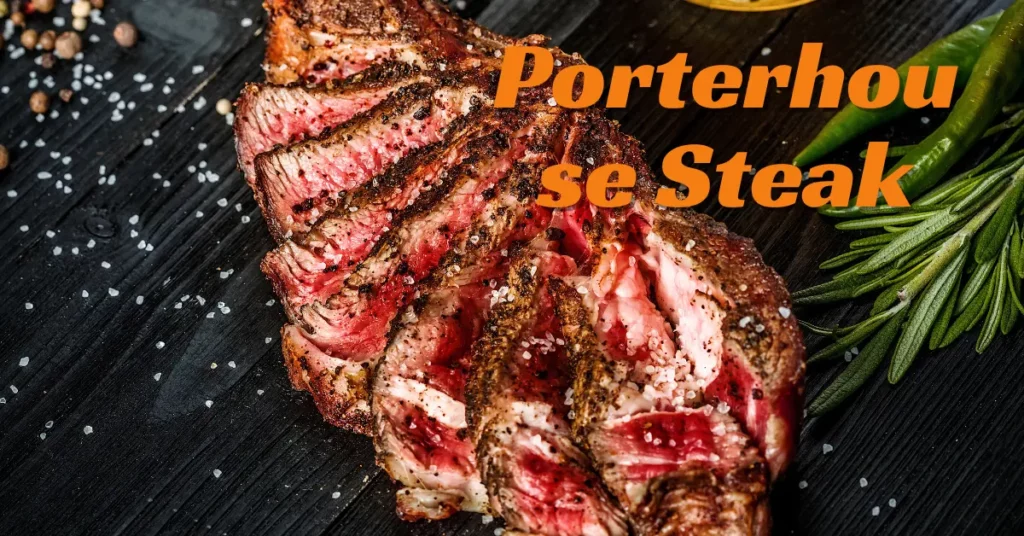This post may contain affiliate links. If you use these links to buy something we may earn a small commission. Thanks.
A Porterhouse steak is one of the most sought-after cuts of beef, prized for its rich marbling and the perfect combination of tenderloin and strip steak in one. This king-sized steak is known for its bold flavor, juicy texture, and impressive presentation, making it ideal for special occasions or a satisfying weekend meal.
Cooking a Porterhouse steak to perfection requires technique, precision, and the right seasoning. Whether you prefer to pan-sear it in a cast-iron skillet or fire it up on the grill, this guide will walk you through every step to achieve a mouthwatering, restaurant-quality Porterhouse steak right at home.
Ingredients & Equipment
Ingredients:
- 1 Porterhouse steak (at least 1.5–2 inches thick)
- Kosher salt (to enhance the beef’s natural flavors)
- Freshly ground black pepper (adds depth to the crust)
- 2 tablespoons olive oil or avocado oil (for high-heat cooking)
- 2 tablespoons unsalted butter (for extra richness)
- 2 cloves garlic (smashed) (infuses aromatic flavor)
- 2 sprigs fresh rosemary or thyme (for a hint of herbal freshness)
Equipment:
- Cast-iron skillet or grill
- Tongs (for flipping without piercing the meat)
- Meat thermometer (for precise doneness)
- Aluminum foil (for resting the steak)
Preparation Steps
1. Choose the Right Steak
Selecting a high-quality Porterhouse steak is crucial for a superior taste and texture. Look for a well-marbled cut, USDA Prime or Choice grade, ensuring a juicy and flavorful experience. The thickness should be at least 1.5 inches to prevent overcooking.

2. Seasoning for Maximum Flavor
For the best results, season your Porterhouse steak generously with kosher salt and black pepper. You can do this at least 40 minutes before cooking or, for even better results, overnight dry brining in the refrigerator. This process enhances the steak’s natural flavors and helps retain moisture during cooking.
3. Bring to Room Temperature
Before cooking, let the steak sit at room temperature for 30–45 minutes. This ensures even cooking, preventing a cold center and promoting a consistent sear.
Cooking Methods
A. Pan-Seared Porterhouse Steak (Cast-Iron Skillet Method)
If you prefer a crispy, flavorful crust with a butter-basted finish, pan-searing is an excellent choice.
1. Preheat the Skillet
- Place a cast-iron skillet on high heat for 5 minutes until it’s smoking hot.
- Add 2 tablespoons of oil and allow it to heat until shimmering.
2. Sear the Steak
- Place the Porterhouse steak in the skillet and press down slightly to ensure maximum contact.
- Sear for 2–3 minutes per side until a deep golden-brown crust forms.
3. Baste with Butter & Aromatics
- Reduce heat to medium and add butter, smashed garlic, and rosemary/thyme to the pan.
- Using a spoon, continuously baste the steak with the melted butter for 1–2 minutes.
4. Check the Internal Temperature
Use a meat thermometer to check doneness:
- Rare: 120–125°F
- Medium-Rare: 130–135°F
- Medium: 140–145°F
5. Rest the Steak
- Remove the steak from the skillet and place it on a cutting board.
- Tent with aluminum foil and let it rest for 5–10 minutes to allow juices to redistribute.
B. Grilled Porterhouse Steak
For those who love smoky, flame-kissed flavor, grilling a Porterhouse steak is the ultimate method.
1. Preheat the Grill
- Set up a two-zone fire by heating one side of the grill to high heat (450–500°F) and the other to medium heat.
2. Sear Over Direct Heat
- Place the steak over direct high heat and sear for 3–4 minutes per side, flipping only once.
3. Finish Over Indirect Heat
- Move the steak to the cooler side of the grill and continue cooking until it reaches the desired internal temperature (refer to temperature guide above).
4. Rest Before Serving
- Transfer the steak to a plate and let it rest for 5–10 minutes before slicing.
Serving Suggestions
A perfectly cooked Porterhouse steak deserves equally delicious side dishes. Here are a few great pairings:
- Roasted Garlic Mashed Potatoes – Creamy and buttery, they balance the richness of the steak.
- Grilled Asparagus – Adds a light, charred flavor that complements the meat.
- Sautéed Mushrooms – Earthy and umami-rich, a perfect match for steak.
- Homemade Chimichurri Sauce – A tangy, herby contrast to the beef’s richness.
- Compound Butter – A dollop of garlic herb or blue cheese butter enhances every bite.
Expert Tips for the Best Porterhouse Steak
1. Use a Meat Thermometer
For guaranteed perfection, always check the internal temperature rather than guessing.
2. Let It Rest
Resting the steak allows the juices to redistribute, making every bite tender and juicy.
3. Don’t Overcomplicate Seasoning
Salt and pepper bring out the best in steak. While marinades are great, a simple seasoning enhances natural flavors.
4. Use High-Quality Butter
When basting, always opt for unsalted, high-quality butter to achieve a rich, buttery taste.
5. Experiment with Reverse Searing
For an ultra-even cook, try reverse searing—start the steak in a low oven (250°F) or over indirect grill heat until it reaches 110°F, then sear it over high heat for a perfect crust.
Conclusion
Cooking a Porterhouse steak to perfection is easier than it seems, whether you’re searing it in a cast-iron skillet or grilling it over an open flame. By following these step-by-step techniques, you’ll achieve a beautifully crusted, juicy, and flavorful steak every time.
With the right ingredients, proper seasoning, and an understanding of cooking temperatures, your Porterhouse steak will be better than any steakhouse version. Fire up your skillet or grill, and enjoy an incredible home-cooked steak experience.
